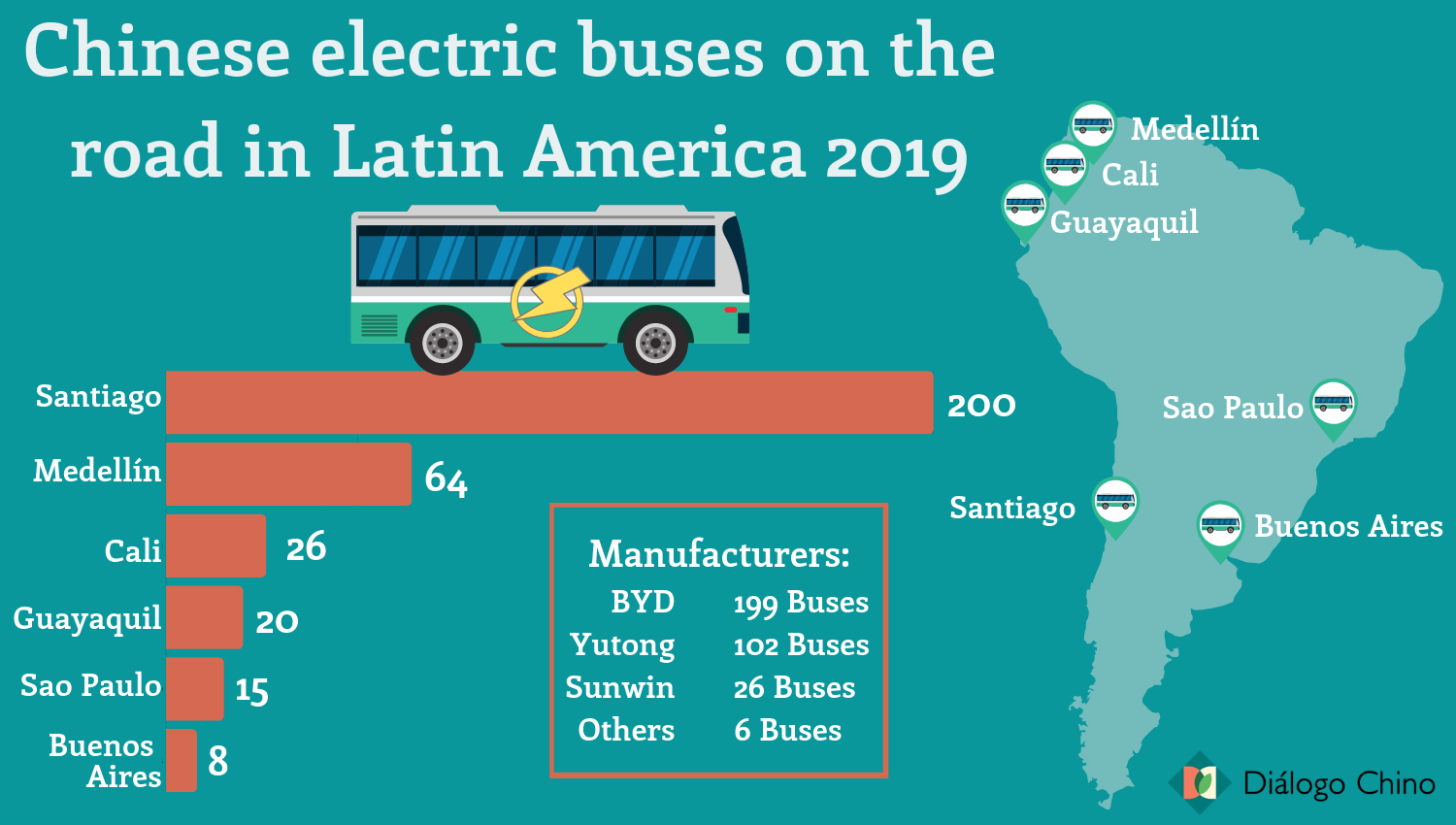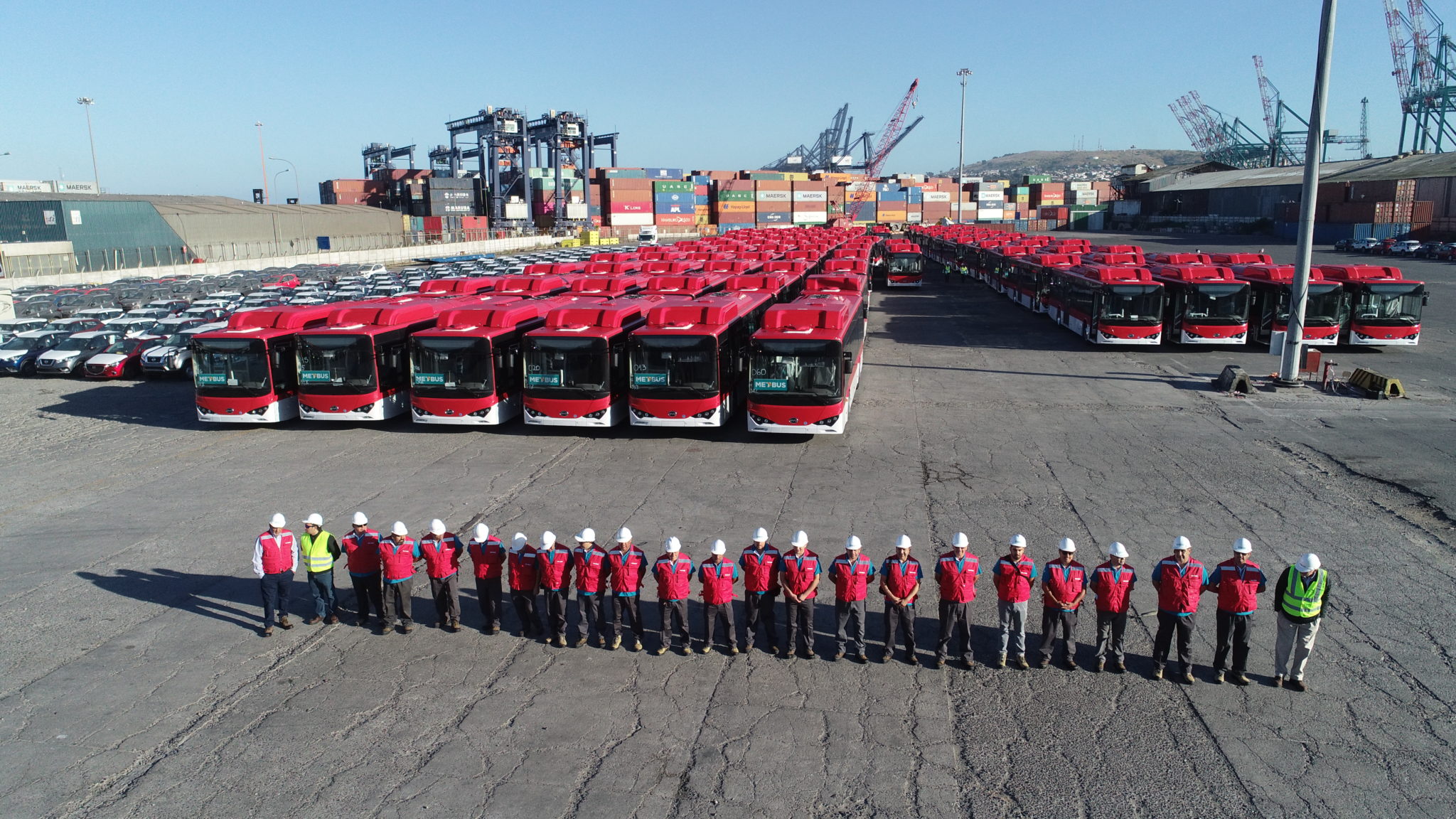This year looks set to be the one Chinese electric buses finally arrive on the roads in Latin America, a market identified as a priority by manufacturers years ago but that, until now, has been sceptical about the new technology.
Most countries in the region have prioritised moving towards cleaner energies in public transport to reduce their carbon footprint in the most populated cities. Yet electric buses, the main manufacturer of which is China, have encountered many entry barriers.
As Diálogo Chino reported recently, Colombian capital Bogotá renewed its fleet of 1160 buses in 2018, rejecting Chinese electric options. The tendering process highlighted several obstacles: the absence of national financing models for the purchase of buses, which are more expensive than diesel or natural gas, and charging points; the lack of trained personnel in this technology; and even the poor perception many countries have of Chinese products.
This has prevented electric bsses from reaching their potential in a region where greenhouse gas emissions in the energy sector are growing faster than in any other.
“If the current fleet of buses and taxis in 22 Latin American cities were immediately replaced with electric vehicles, the region could save almost US$64 billion in fuel by 2030 and prevent the emission of 300 million tonnes of carbon dioxide,” according to researchers Carlos Mojica, Lisa Viscidi and Guy Edwards, who wrote a comprehensive report on the current state of the electric car market in Latin America.
However, the picture could change. Four large cities with a combined 14 million inhabitants will debut fleets of Chinese electric buses over the first half of 2019. Another four will introduce pilot schemes. Which are they?

Santiago, Chile
Since mid-December, 100 electric buses manufactured by China’s BYD have been deployed in Santiago, making the Chilean capital the owner of the largest electric fleet in Latin America and the second largest of any city in the world outside China.
Transantiago, Santiago’s Bus Rapid Transport system (BRT) will add a further 100 made by Yutong that arrived in Chile in mid-January. They are the driving force behind Santiago’s quest to make public transport greener in a city where pollution and air quality have become issues of high concern for the public. The city will also add another 490 buses powered by diesel engines, although they will be Euro VI standard, a cleaner technology.
Transantiago, which transports 60% of Santiago’s population, solved some of the problems that have come up in other countries attempts to introduce electric buses. The deal was financed by the government of Sebastián Piñera, who personally presented the first buses in December and who made ‘electromobility’ into one of the central pillars of his 2018-2022 Energy Roadmap. Among other commitments, the plan promised to multiply the number of electric vehicles operating by ten within three years.
Italian electricity giant Enel is working closely with bus operators to install 100 charging points in the city.
“The purchase of electric buses was very much influenced by the willingness of the Ministry of Transport and Telecommunications to have this fleet. Unlike previous cases, it was the Ministry itself that bought the buses through direct deals, without bidding. This, coupled with Enel’s support, especially in terms of providing charging infrastructure, made the process much faster,” explains Franco Basso, director of the Center for Innovation in Transport and Logistics at Diego Portales University.
“The case of Santiago is also very interesting because there is an alliance between private operators, manufacturers and energy distributors,” says Darío Hidalgo, a researcher at the World Resources Institute’s Ross Center for Sustainable Cities.
Medellín and Cali, Colombia
Late last year, Medellín announced that Chinese company BYD had won the contract to bring 64 electric buses to Colombia.
With the incorporation of these vehicles to the Metroplús system in August, Colombia’s second city will also become the owner of the second largest electric fleet in the Latin America region after Santiago. The purchase, 100% funded by the local government, was decided after a tender in which two others bidders also offered to supply Chinese-made Yutong and Zhongtong buses.
Medellín will be followed closely by Cali, which announced a few weeks previously its eventual goal is to have 125 electric buses in the MIO transport system. The first batch of 26 vehicles, manufactured by the Chinese company Sunwin Bus Corporation, will arrive in May to the third-largest Colombian city.
Medellín and Cali will therefore become the first cities to advance in the goal set by Colombia in commitments under the Paris Agreement to replace 75% of public buses in seven cities with zero emission vehicles by 2040.
Electric technology has an additional attraction for Colombia. Given that 70% of electricity comes from hydroelectric plants, the country has a much cleaner energy matrix in terms of new emissions than most others and, therefore, these buses will contribute to an even greener energy scheme.
One reason why both cities managed to introduce electric buses before Bogota is that China already has a solid market for ordinary electric buses but has so far failed to produce reliable articulated and double-articulated buses, as Bogota’s Transmilenio system requires.

Guayaquil, Ecuador
The port of Guayaquil, the most populous city in Ecuador, will also debut 20 buses manufactured by BYD this year.
However, unlike Santiago and Medellín, this initiative was led by one of the city’s private transport operators. Saucinc, a small company which operates one specific route, turned to the national government for help in replacing its fleet of diesel-powered buses with electric ones.
Like Chile, Guayaquil garnered state support through a special credit from the National Finance Corporation (CFN), which financed half of the purchase. There is also a law that exempts electric buses from paying import tariffs and value-added tax (VAT).
These efforts could benefit the capital Quito too, since one of its transport operators was also in China exploring the possibility of buying between 20 and 60 electric buses which, like Bogotá, would have to be bi-articulated.
New pilots
Beyond these cities, at least four other cities in Latin America announced they will start pilots with electric buses this year, most of them manufactured in China.
Sao Paulo (Brazil), which has a fleet of 14,000 public buses, announced in October that it will start a pilot with 15 electric buses. The vehicles produced by BYD, which has a factory in the nearby city of Campinas, were delivered a month ago and will hit the roads in March.
Buenos Aires (Argentina) announced last week that it will carry out a pilot with 8 buses starting in May. Unlike the other cities, there will be four different Chinese manufacturers (Yutong, Zhongtong Bus, Higer Bus and King Long), working in partnership with Enel.
San José (Costa Rica) will debut three buses, thanks to a donation from Germany and another from a local foundation for sustainable development. The Central American country was one of the pioneers in the region to pass a law with economic incentives for electric transport.
In Montevideo (Uruguay), the national government requested a loan from the Green Climate Fund (GCF), one of the financial mechanisms created by the Paris Agreement to facilitate initiatives that reduce greenhouse gas emissions. This would allow the Uruguayan capital to replace 120 buses, some 10% of its fleet.





![A view of receding flood waters in Srinagar city during the September 2014 flooding. [image: Athar Parvaiz]](https://dialogue.earth/content/uploads/2017/11/A-view-of-receding-flood-waters-in-Srinagar-city-during-the-September-2014-flooding-Credit-Athar-Parvaiz-e1509633052651-300x225.jpg)



![Women in Kapri village Bajura, western Nepal, preparing millet for use after harvest [Image by Nabin Baral]](https://dialogue.earth/content/uploads/2019/01/photos-for-story-two-1-300x200.jpg)